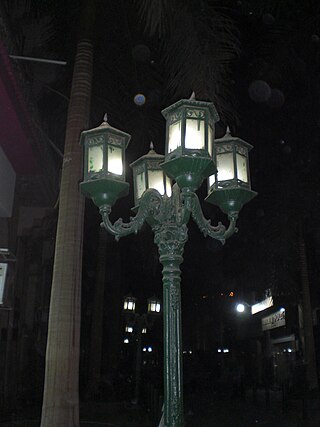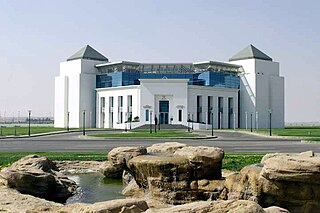Related Research Articles

Aswan is a city in Southern Egypt, and is the capital of the Aswan Governorate.

Cairo is the capital of Egypt and the Cairo Governorate, and is the country's largest city, being home to more than 10 million people. It is also part of the largest urban agglomeration in Africa, the Arab world and the Middle East. The Greater Cairo metropolitan area is the 12th-largest in the world by population with over 22.1 million people.

Egyptology is the scientific study of ancient Egypt. The topics studied include ancient Egyptian history, language, literature, religion, architecture and art from the 5th millennium BC until the end of its native religious practices in the 4th century AD.

The Museum of Egyptian Antiquities, commonly known as the Egyptian Museum, located in Cairo, Egypt, houses the largest collection of Egyptian antiquities in the world. It houses over 120,000 items, with a representative amount on display. Located in Tahrir Square in a building built in 1901, it is the largest museum in Africa. Among its masterpieces are Pharaoh Tutankhamun's treasure, including its iconic gold burial mask, widely considered one of the best-known works of art in the world and a prominent symbol of ancient Egypt.

The Great Sphinx of Giza is a limestone statue of a reclining sphinx, a mythical creature with the head of a human and the body of a lion. Facing directly from west to east, it stands on the Giza Plateau on the west bank of the Nile in Giza, Egypt. The face of the Sphinx appears to represent the pharaoh Khafre. The original shape of the Sphinx was cut from bedrock, and has since been restored with layers of limestone blocks. It measures 73 m (240 ft) long from paw to tail, 20 m (66 ft) high from the base to the top of the head and 19 m (62 ft) wide at its rear haunches.

Zahi Abass Hawass is an Egyptian archaeologist, Egyptologist, and former Minister of State for Antiquities Affairs, serving twice. He has also worked at archaeological sites in the Nile Delta, the Western Desert and the Upper Nile Valley.
The American University in Cairo is a private research university in New Cairo, Egypt. The university offers American-style learning programs at undergraduate, graduate, and professional levels, along with a continuing education program.

Mark Lehner is an American archaeologist with more than 30 years of experience excavating in Egypt. He is the director of Ancient Egypt Research Associates (AERA) and has appeared in numerous television documentaries.

The Arab Academy for Science, Technology & Maritime Transport (AASTMT) or (AAST) is a regional university operated by the Arab League, which runs programs in marine transportation, business, and engineering. AASTMT started as a notion in the Arab League Transport Committee's meetings on 11th of March, 1970. The Academy's inception was in 1972 in the city of Alexandria, Egypt. Later on, it expanded into Cairo.
6th of October is a city in the Giza Governorate of Egypt. It is a satellite city, located adjacent to Giza, and is part of the Greater Cairo region.

Salima Ikram is a Pakistani professor of Egyptology at the American University in Cairo, a participant in many Egyptian archaeological projects, the author of several books on Egyptian archaeology, a contributor to various magazines and a guest on pertinent television programs.

Tahrir Square, also known as Martyr Square, is a public town square in downtown Cairo, Egypt. The square has been the location and focus for political demonstrations. The 2011 Egyptian revolution and the resignation of President Hosni Mubarak occurred at the Tahrir Square.

Qasr El Nil Street, is a street in downtown Cairo, Egypt, one of the biggest streets in Cairo, with many businesses, restaurants, and an active nightlife.

The Center for Documentation of Cultural and Natural Heritage (CULTNAT) of the Cultural Outreach Sector of the Bibliotheca Alexandrina plays an important and unique role in documenting Egypt's cultural heritage in its tangible and intangible aspects, besides Egypt's natural heritage from protectorates and wildlife. The center has contributed, for nearly two decades, to documenting and disseminating information related to heritage through the implementation of many projects for digital documentation of Egyptian heritage using the latest information technology technologies in cooperation with specialized local and international bodies and the center is keen to increase awareness of cultural and natural heritage and the Egyptian identity by benefiting from various media channels. CULTNAT also builds the capacities of workers in the field of documenting and preserving civilizational and natural heritage. It was established in 2000, and is located in Smart Village.
Lara Baladi is an acclaimed Egyptian-Lebanese photographer, archivist and multimedia artist. She was educated in Paris and London and currently lives in Cairo. Baladi exhibits and publishes worldwide. Her body of work encompasses photography, video, visual montages/collages, installations, architectural constructions, tapestries, sculptures and even perfume. Much of her work reflects her "concerns with Egypt's extremely alarming sociopolitical context."

The Sphinx water erosion hypothesis is a fringe claim, contending that the Great Sphinx of Giza and its enclosing walls eroded primarily due to ancient floods or rainfalls, attributing their creation to Plato's lost civilization of Atlantis over 11,500 years ago.
Colleen Darnell is an American Egyptologist, whose expertise includes Late Period uses of the Underworld Books, ancient Egyptian military history, the literature of New Kingdom Egypt, and Egyptian revival history.
Rape in Egypt is a criminal offense with penalties ranging from lifetime sentence to capital punishment. Marital rape is legal. By 2008, the U.N. quoted Egypt's Interior Ministry's figure that 20,000 rapes take place every year, although according to the activist Engy Ghozlan (ECWR), rapes are 10 times higher than the stats given by Interior Ministry, making it 200,000 per year. Mona Eltahawy has also noted the same figure (200,000), and added that this was before the revolution.

The mass sexual assault of women in public has been documented in Egypt since 2005, when Egyptian security forces and their agents were accused of using it as a weapon against female protesters during a political demonstration in Tahrir Square, Cairo on 25 May. The behavior spread, and by 2012 sexual assault by crowds of young men was seen at protests and festivals in Egypt.

The Pharaohs' Golden Parade was an event held in Cairo, Egypt on 3 April 2021, during which twenty-two mummies belonging to Kings and Queens of the New Kingdom of Ancient Egypt were moved from the Egyptian Museum in Tahrir Square to the National Museum of Egyptian Civilization in Fustat.
References
- ↑ "Monica Hanna". Hyperallergic. Retrieved 2021-04-03.
- 1 2 "Saving Heritage". EgyptToday. 2013-12-15. Retrieved 2021-04-03.
- ↑ "Alumna Monica Hanna Internationally Awarded for Saving Antiquities | The American University in Cairo". www.aucegypt.edu. Retrieved 2021-04-03.
- ↑ "Egyptian archaeologists rely on technology to preserve past". Al Monitor: The Pulse of the Middle East. Retrieved 2021-04-03.
- ↑ "Egyptologists attack transfer of sphinxes to Tahrir Square". the Guardian. 2020-05-07. Retrieved 2021-04-03.
- ↑ "Relocation of Egyptian Sphinxes Exposes Them to Potential Environmental Damage, Experts Fear | The Weather Channel - Articles from The Weather Channel | weather.com". The Weather Channel. Retrieved 2021-04-03.